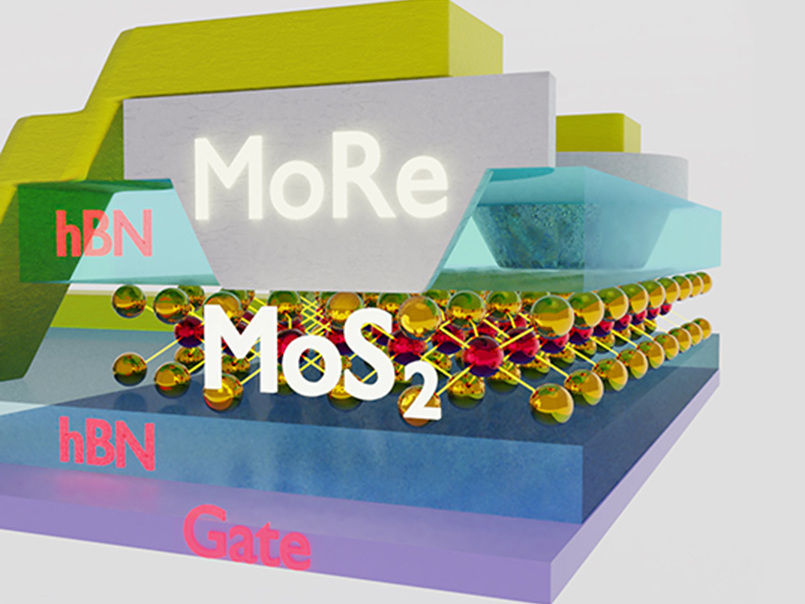Ultrathin semiconductors electrically connected to superconductors for the first time
New properties and phenomena
For the first time, University of Basel researchers have equipped an ultrathin semiconductor with superconducting contacts. These extremely thin materials with novel electronic and optical properties could pave the way for previously unimagined applications. Combined with superconductors, they are expected to give rise to new quantum phenomena and find use in quantum technology.

The monolayer of molybdenum disulfide (MoS2) is sandwiched between two protective layers of boron nitride (hBN), with molybdenum rhenium (MoRe) contacts extending through the upper one. A layer of graphene (gate) is used for electrical control.
Mehdi Ramezani, Swiss Nanoscience Institute, University of Basel
Whether in smartphones, televisions or building technology, semiconductors play a central role in electronics and therefore in our everyday lives. In contrast to metals, it is possible to adjust their electrical conductivity by applying a voltage and hence to switch the current flow on and off.
With a view to future applications in electronics and quantum technology, researchers are focusing on the development of new components that consist of a single layer (monolayer) of a semiconducting material. Some naturally occurring materials with semiconducting properties feature monolayers of this kind, stacked to form a three-dimensional crystal. In the laboratory, researchers can separate these layers – which are no thicker than a single molecule – and use them to build electronic components.
New properties and phenomena
These ultrathin semiconductors promise to deliver unique characteristics that are otherwise very difficult to control, such as the use of electric fields to influence the magnetic moments of the electrons. In addition, complex quantum mechanical phenomena take place in these semiconducting monolayers that may have applications in quantum technology.
Scientists worldwide are investigating how these thin semiconductors can be stacked to form new synthetic materials, known as van der Waals heterostructures. However, until now, they have not succeeded in combining such a monolayer with superconducting contacts in order to dig deeper into the properties and peculiarities of the new materials.
Superconducting contacts
A team of physicists, led by Dr. Andreas Baumgartner in the research group of Professor Christian Schönenberger at the Swiss Nanoscience Institute and the Department of Physics of the University of Basel, has now fitted a monolayer of the semiconductor molybdenum disulfide with superconducting contacts for the first time.
The reason why this combination of semiconductor and superconductor is so interesting is that the experts expect components of this kind to exhibit new properties and physical phenomena. “In a superconductor, the electrons arrange themselves into pairs, like partners in a dance – with weird and wonderful consequences, such as the flow of the electrical current without a resistance,” explains Baumgartner, the project manager of the study. “In the semiconductor molybdenum disulfide, on the other hand, the electrons perform a completely different dance, a strange solo routine that also incorporates their magnetic moments. Now we would like to find out which new and exotic dances the electrons agree upon if we combine these materials.”
Suitable for use as a platform
The electrical measurements at the low temperatures required for superconductivity – just above absolute zero (-273.15°C) – show clearly the effects caused by the superconductor; for example, at certain energies, single electrons are no longer allowed. Moreover, the researchers found indications of a strong coupling between the semiconductor layer and the superconductor.
“Strong coupling is a key element in the new and exciting physical phenomena that we expect to see in such van der Waals heterostructures, but were never able to demonstrate,” says Mehdi Ramezani, lead author of the study.
“And, of course, we always hope for new applications in electronics and quantum technology,” says Baumgartner. “In principle, the vertical contacts we’ve developed for the semiconductor layers can be applied to a large number of semiconductors. Our measurements show that these hybrid monolayer semiconductor components are indeed possible –perhaps even with other, more exotic contact materials that would pave the way for further insights,” he adds.



























































